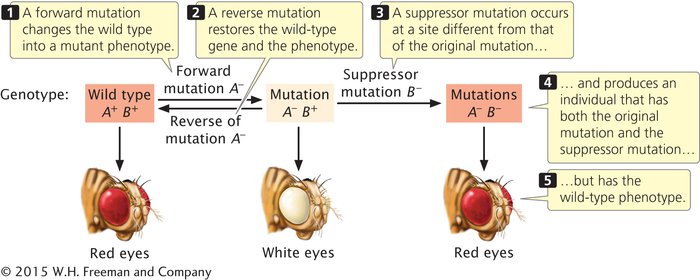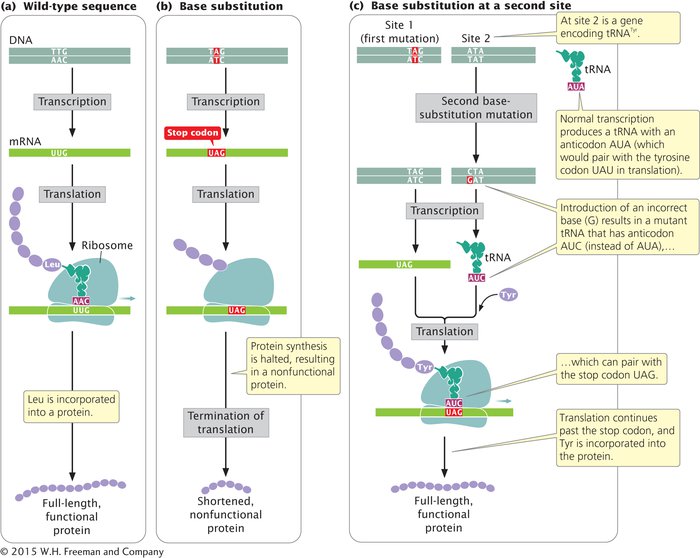Suppressor Mutations
A suppressor mutation is a genetic change that hides or suppresses the effect of another mutation. This type of mutation is different from a reverse mutation, in which the mutated site changes back into the original wild-

INTRAGENIC SUPPRESSOR MUTATIONS An intragenic suppressor mutation takes place in the same gene that contains the mutation being suppressed. It may work in any of several ways. The suppressor may change a second nucleotide in the same codon altered by the original mutation, producing a codon that specifies the same amino acid that was specified by the original, nonmutated codon (Figure 13.8).

Intragenic suppressors may also work by suppressing a frameshift mutation. If the original mutation, for example, is a one-

Suppose that a one-

If a single nucleotide is added to the third codon (the suppressor mutation), the reading frame is restored, although two of the amino acids differ from those specified by the original sequence.

Similarly, a mutation due to an insertion may be suppressed by a subsequent deletion in the same gene.
A third way in which an intragenic suppressor may work is by making compensatory changes in the protein. A first missense mutation can alter the folding of a polypeptide chain by changing the way in which amino acids in the protein interact with one another. A second missense mutation at a different site (the suppressor) can recreate the original folding pattern by restoring interactions between the amino acids.
INTERGENIC SUPPRESSOR MUTATIONS An intergenic suppressor mutation occurs in a gene other than the one bearing the original mutation. These suppressors sometimes work by changing the way that the mRNA is translated. In the example illustrated in Figure 13.9a, the original DNA sequence is AAC (UUG in the mRNA) and specifies leucine. This sequence mutates to ATC (UAG in mRNA), a stop codon (Figure 13.9b). The ATC nonsense mutation could be suppressed by a second mutation in a different gene that encodes a tRNA; this second mutation would result in a codon capable of pairing with the UAG stop codon (Figure 13.9c). For example, the gene that encodes the tRNA for tyrosine (tRNATyr), which has the anticodon AUA, might be mutated to have the anticodon AUC, which would then pair with the UAG stop codon. Instead of translation terminating at the UAG codon, tyrosine would be inserted into the protein, and a full-

Because cells in many organisms have multiple copies of tRNA genes, other nonmutated copies of tRNATyr would remain available to recognize tyrosine codons in the transcripts of the mutant gene in question and in other genes being expressed concurrently. We might expect that the tRNAs that have undergone the suppressor mutation just described would also suppress the normal stop codons at the ends of other coding sequences, resulting in the production of longer-
Characteristics of some of the different types of mutations are summarized in Table 13.2.
| Type of mutation | Definition |
|---|---|
| Base substitution | Changes a single DNA nucleotide |
| Transition | Base substitution in which a purine replaces a purine or a pyrimidine replaces a pyrimidine |
| Transversion | Base substitution in which a purine replaces a pyrimidine or a pyrimidine replaces a purine |
| Insertion | Addition of one or more nucleotides |
| Deletion | Deletion of one or more nucleotides |
| Frameshift mutation | Insertion or deletion that alters the reading frame of a gene |
| In- |
Deletion or insertion of a multiple of three nucleotides that does not alter the reading frame |
| Expanding nucleotide repeats | Increases the number of copies of a set of nucleotides |
| Forward mutation | Changes the wild- |
| Reverse mutation | Changes a mutant phenotype back to the wild- |
| Missense mutation | Changes a sense codon into a different sense codon, resulting in the incorporation of a different amino acid in the protein |
| Nonsense mutation | Changes a sense codon into a nonsense (stop) codon, causing premature termination of translation |
| Silent mutation | Changes a sense codon into a synonymous codon, leaving the amino acid sequence of the protein unchanged |
| Neutral mutation | Changes the amino acid sequence of a protein without altering its ability to function |
| Loss- |
Causes a complete or partial loss of function |
| Gain- |
Causes the appearance of a new trait or function or causes the appearance of a trait in inappropriate tissue or at an inappropriate time |
| Lethal mutation | Causes premature death |
| Suppressor mutation | Suppresses the effect of an earlier mutation at a different site |
| Intragenic suppressor mutation | Suppresses the effect of an earlier mutation within the same gene |
| Intergenic suppressor mutation | Suppresses the effect of an earlier mutation in another gene |
CONCEPTS
A suppressor mutation overrides the effect of an earlier mutation at a different site. An intragenic suppressor mutation occurs within the same gene as that containing the original mutation; an intergenic suppressor mutation occurs in a different gene.
 CONCEPT CHECK 2
CONCEPT CHECK 2
How does a suppressor mutation differ from a reverse mutation?
A reverse mutation restores the original phenotype by changing the DNA sequence back to the wild type. A suppressor mutation restores the phenotype by causing an additional change in the DNA at a site that is different from that of the original mutation.